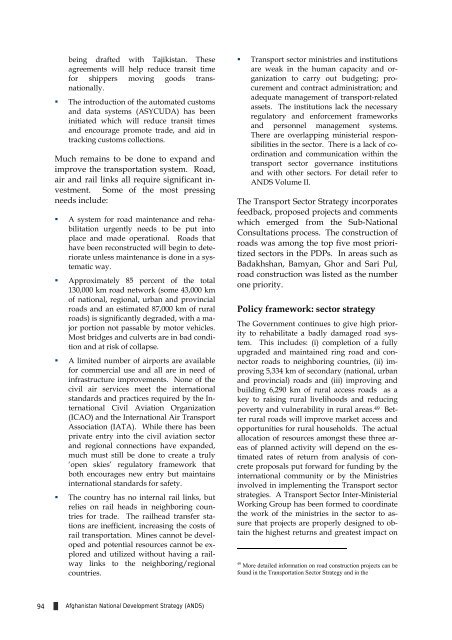Islamic Republic of Afghanistan - Enhanced Integrated Framework ...
Islamic Republic of Afghanistan - Enhanced Integrated Framework ...
Islamic Republic of Afghanistan - Enhanced Integrated Framework ...
Create successful ePaper yourself
Turn your PDF publications into a flip-book with our unique Google optimized e-Paper software.
eing drafted with Tajikistan. Theseagreements will help reduce transit timefor shippers moving goods transnationally.• The introduction <strong>of</strong> the automated customsand data systems (ASYCUDA) has beeninitiated which will reduce transit timesand encourage promote trade, and aid intracking customs collections.Much remains to be done to expand andimprove the transportation system. Road,air and rail links all require significant investment.Some <strong>of</strong> the most pressingneeds include:• A system for road maintenance and rehabilitationurgently needs to be put intoplace and made operational. Roads thathave been reconstructed will begin to deteriorateunless maintenance is done in a systematicway.• Approximately 85 percent <strong>of</strong> the total130,000 km road network (some 43,000 km<strong>of</strong> national, regional, urban and provincialroads and an estimated 87,000 km <strong>of</strong> ruralroads) is significantly degraded, with a majorportion not passable by motor vehicles.Most bridges and culverts are in bad conditionand at risk <strong>of</strong> collapse.• A limited number <strong>of</strong> airports are availablefor commercial use and all are in need <strong>of</strong>infrastructure improvements. None <strong>of</strong> thecivil air services meet the internationalstandards and practices required by the InternationalCivil Aviation Organization(ICAO) and the International Air TransportAssociation (IATA). While there has beenprivate entry into the civil aviation sectorand regional connections have expanded,much must still be done to create a truly‘open skies’ regulatory framework thatboth encourages new entry but maintainsinternational standards for safety.• The country has no internal rail links, butrelies on rail heads in neighboring countriesfor trade. The railhead transfer stationsare inefficient, increasing the costs <strong>of</strong>rail transportation. Mines cannot be developedand potential resources cannot be exploredand utilized without having a railwaylinks to the neighboring/regionalcountries.• Transport sector ministries and institutionsare weak in the human capacity and organizationto carry out budgeting; procurementand contract administration; andadequate management <strong>of</strong> transport-relatedassets. The institutions lack the necessaryregulatory and enforcement frameworksand personnel management systems.There are overlapping ministerial responsibilitiesin the sector. There is a lack <strong>of</strong> coordinationand communication within thetransport sector governance institutionsand with other sectors. For detail refer toANDS Volume II.The Transport Sector Strategy incorporatesfeedback, proposed projects and commentswhich emerged from the Sub-NationalConsultations process. The construction <strong>of</strong>roads was among the top five most prioritizedsectors in the PDPs. In areas such asBadakhshan, Bamyan, Ghor and Sari Pul,road construction was listed as the numberone priority.Policy framework: sector strategyThe Government continues to give high priorityto rehabilitate a badly damaged road system.This includes: (i) completion <strong>of</strong> a fullyupgraded and maintained ring road and connectorroads to neighboring countries, (ii) improving5,334 km <strong>of</strong> secondary (national, urbanand provincial) roads and (iii) improving andbuilding 6,290 km <strong>of</strong> rural access roads as akey to raising rural livelihoods and reducingpoverty and vulnerability in rural areas. 49 Betterrural roads will improve market access andopportunities for rural households. The actualallocation <strong>of</strong> resources amongst these three areas<strong>of</strong> planned activity will depend on the estimatedrates <strong>of</strong> return from analysis <strong>of</strong> concreteproposals put forward for funding by theinternational community or by the Ministriesinvolved in implementing the Transport sectorstrategies. A Transport Sector Inter-MinisterialWorking Group has been formed to coordinatethe work <strong>of</strong> the ministries in the sector to assurethat projects are properly designed to obtainthe highest returns and greatest impact on49 More detailed information on road construction projects can befound in the Transportation Sector Strategy and in the94<strong>Afghanistan</strong> National Development Strategy (ANDS)
















